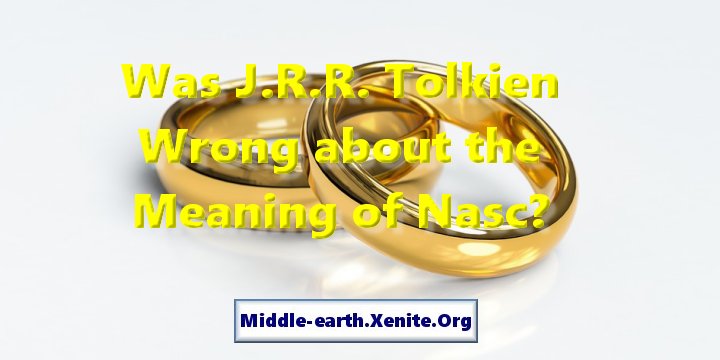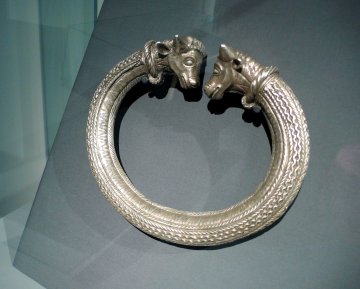
Q: Was J.R.R. Tolkien Wrong about the Meaning of Nasc?
ANSWER: I wrote the first draft for this article in June 2014. I’ve let it sit in the queue all these years because I felt that it might need a little more research. To be honest, I don’t think I’ll find anything more. The reference is quite obscure and I doubt many people care much about this “controversy”. Also, I rarely take on etymological questions because that isn’t my field of study.

One of the passages from The Letters of J.R.R. Tolkien which I often see quoted concerns his source for the Black Speech word nazg, which Tolkien conceded was probably a rare borrowing from Irish Gaelic:
nazg: the word for ‘ring’ m the Black Speech. This was devised to be a vocable as distinct in style and phonetic content from words of the same meaning in Elvish, or in other real languages that are most familiar: English, Latin, Greek, etc. Though actual congruences (of form + sense) occur in unrelated real languages, and it is impossible in constructing imaginary languages from a limited number of component sounds to avoid such resemblances (if one tries to – 1 do not), it remains remarkable that nasc is the word for ‘ring’ in Gaelic (Irish: in Scottish usually written nasg). It also fits well in meaning, since it also means, and prob. originally meant, a bond, and can be used for an ‘obligation’. Nonetheless I only became aware, or again aware, of its existence recently in looking for something in a Gaelic dictionary. I have no liking at all for Gaelic from Old Irish downwards, as a language, but it is of course of great historical and philological interest, and I have at various times studied it. (With alas! very little success.) It is thus probable that nazg is actually derived from it, and this short, hard and clear vocable, sticking out from what seems to me (an unloving alien) a mushy language, became lodged in some comer of my linguistic memory.
Every once in a while I see a native Irish speaker express mild dismay at this translation; in fact, a member of the Tolkien linguistic community who had casually mentioned Tolkien’s use of nasc was once rebutted by someone who knew Irish.
I can find a fair number of Web pages from Ireland that translate nasc as “link”, not “ring”. So it has always puzzled me how Tolkien could claim he found this word in a Gaelic dictionary and made what appears to be a wrong association for it. And that wrong association has been repeated endlessly by Tolkien fans around the world.
The Etymology of Nask
Well, as it turns out (and I am sure many Gaelic scholars already know this), Tolkien’s translation was not incorrect at all. What I think we’re seeing here is an example of how language changes over time. I recently found sources for a book titled An etymological dictionary of the Scottish language; to which is prefixed, a dissertation on the origin of the Scottish language. New ed., carefully rev. and collated, with the entire suppl. incorporated (1879). I don’t know if Tolkien ever read this book; it doesn’t matter. There is an entry therein for the Scottish word Nask which reads (in part): “This term is of Celtic origin: evidently from Gael. nasg, naisg, to bind, make fast….”
Well, there is neither a link nor a ring to be found in THAT note, is there? But there is another old publication in which I found a footnote that translates nasc as “meaning a collar, bracelet, or ear-ring — any ring that opened.” This text is located on page 206 of The Transactions of the Royal Irish Academy, Vol. XVIII, Part I, (1838) in the article titled “Mr. Petrie on the History and Antiquities of Tara Hill”. The article is actually translating some words as “ring-makers”.
If these rings had an opening then they would have included the ancient Celtic Torc. I don’t know anything about the etymology of modern Irish nasc so I cannot explain how it came to mean “link” but there are certainly similarities between rings with openings and links as might be used to make chain-mail. Some sources also translate early Irish nasc as “a bond”, which can also be associated with “link”, but confirms what Tolkien wrote.
Did Tolkien Connect ‘Nasc’ with Enslavement?
The Black Speech word nazg denoting the Rings of Power, and especially the One Ring, might be a subtle nod to the bond Sauron created between the rings. This could be one of Tolkien’s many double entendres, jokes that he might expect only another linguist to recognize and appreciate.
Sauron tricked the Elves of Eregion into creating the Rings of Power so that he could enslave them. He imbued their rings with some of his own power, thus creating a bond between them and his own will. But he needed the One Ring to complete the trap.
Gold and silver torcs were made and used all over ancient Celtic Europe, although experts aren’t really sure of what they were used for. Many but not all torcs were worn, probably only on ceremonial occasions. Most (if not all) experts believe they were status symbols. But, you know, that’s just a theory. And I suspect that as Tolkien looked at the word nasc, he pondered the curious use of the same word for “ring” and “(legal) bond”.
Well, that’s my theory.
(Note: See Barry Stanford’s interesting comment below on the connection between “ring” and “bond”.)
See Also
Shhh! It’s A Secret Ring! (Classic Essay)
Who Were the Rings of Power Made for?
Why Did Sauron Take Back the Dwarven Rings of Power?
How Much Was Tolkien Inspired by Wagner’s Ring Cycle?
Was Tolkien’s One Ring Inspired by the Cursed Ring of Silvanus?
# # #
Have you read our other Tolkien and Middle-earth Questions and Answers articles?

http://edil.qub.ac.uk/32985 nasc has two general meanings: a piece of jewellery as well as a bond, the second being a piece of Old Irish legal terminology. Compare the use of naiscid http://edil.qub.ac.uk/32953.
You have the meaning to fasten or bind, but you also have the legal sense of making a ‘binding’ contract, and then there is the third sense (which is really a refinement of the second) which is marriage, the bonds of matrimony. In pre-literate societies where a written contract could not exist, the exchange of personal items in front of witnesses served as a reminder that some form of contract existed which some call trothplight.So there is likely an added meaning to the ring verse: One ‘fastener’ to bring them all and in the darkness ‘fasten’ them.
That makes sense. Thank you.